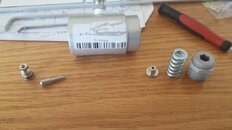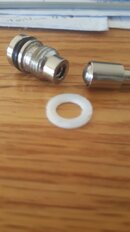I recently bought a PMV for my mobile compressor: Coltri MCH13/16.
After installation I tested the PMV and I came to the conclusion that the "M" in PMV was missing. The only pressure it's maintaining after a few hours is 1 bar, the other 139 bar leaked out.
That's pretty funny, heck its better than that funniest thing I have read about compressors so far on this forum.
Now an explanation is no way near as funny but the best I can do.
When Coltri decided finally to offer a BPR to the small compressor range they copied someone else's design. Now the drawback with copying is that you copy both the good parts of the design and the bad parts, problem is you don't know which is what or indeed how to fix it or alter the performance as you never knew in the first place what the original required design features were.
It's a cheap Italian copy its cheap, it does a job without a design performance but near enough that most users would'nt know or even care the difference.
Now a leak rate in a BPR can be a common part of the design. It's the application in scuba compressors that's the problem.
To get a flow you need a pressure drop and a requirement is you may want to avoid these massive pressure drops or the subsequent disruption of the filter chemical bed and shock loading to the compressor of an explosive pressure blast wave at sonic speed as the BPR goes from fully sealed no flow condition to a pedal to the metal explosive pressure blast fully open condition that is better avoided in the design than compensated for with additional heavy metal and shorter service life expectancy.
In scuba applications small diameter filter tubes although cheap to manufacture are also very susceptible to filter chemical disruption and the smaller the cartrige tube diameter the compressor has the greater the leak rate required from the BPR. Same for oil suction up off the piston rings as the rapid loss of pressure from the piston draws up oil from under the rings as the BPR blast its contents out down the pipework.
The LF BPR also has that same inherent problem as in its design one second its all sealed while the next its a blast wave as the thing opens, then re seals again with the massive pressure drop only to open again and again as this blast stop/start eventually resides when the pressure downstream eventually reached the BPR spring balance and it stays open to flow.
I know that sounds complicated but I'm an engineer not a teacher. I know it shows LOL








